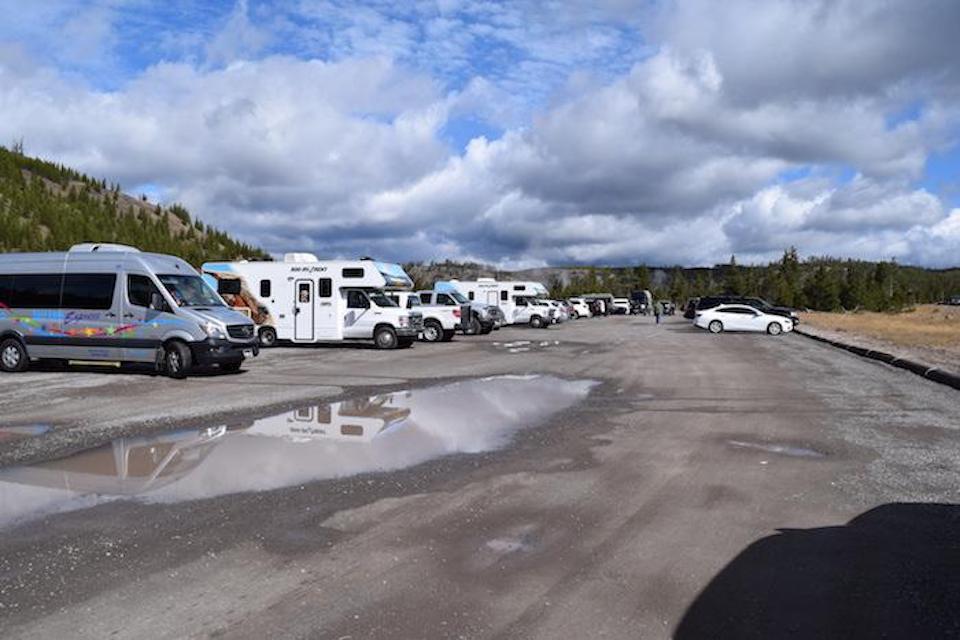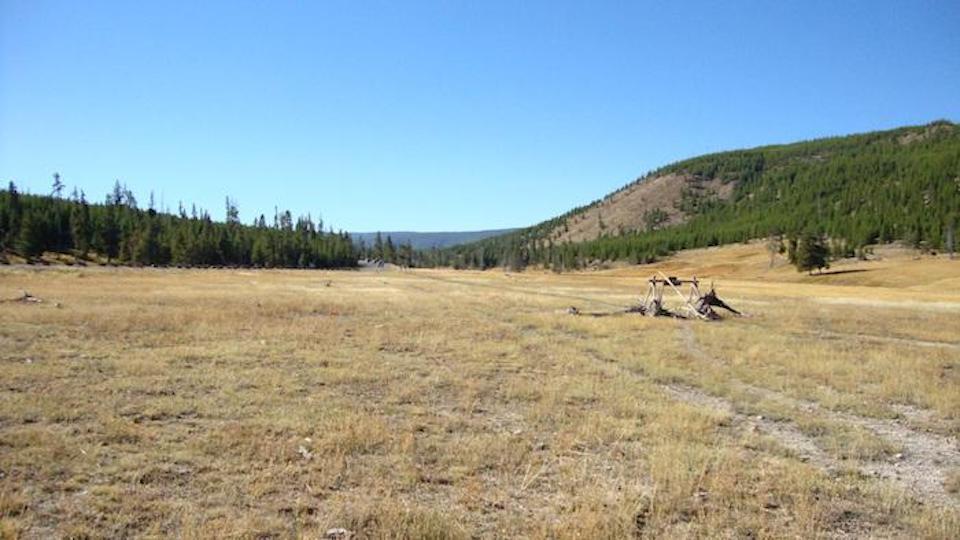
This temporary parking lot near the Fairy Falls Trailhead in Yellowstone will be removed this fall/NPT file
Altering human behavior is proving harder than providing for humans, at least in the case of a temporary parking area created near the Fairy Falls Trailhead in Yellowstone National Park. And because of that, the parking lot will be removed this fall.
"While the lot has alleviated some traffic congestion, it has not substantially improved traffic flows within the area as originally envisioned," said Yellowstone Superintendent Cam Sholly in an email. "Our data shows that social trailing is actually worse in some areas than previous to the parking lot being installed. And without proper supporting infrastructure, like restrooms and trash cans, litter and human waste have been very prevalent in the area."
Even if the park wanted to install restrooms at the parking area, it couldn't because of the geothermal resources in the area, the superintendent said.
Yellowstone officials back in 2016 broached the idea of building the lot on land once traversed by an old stage road. It was needed, they said at the time, because once the existing 55-spot parking lot at Grand Prismatic Spring filled up, visitors would park on the Loop Road that passed the popular spring. Some even parked in the middle of the road, according to park staff.

This ground near the Fairy Falls Trailhead was turned into the temporary parking area in 2017/NPS file
Ideally, rangers would have been positioned there to manage traffic, but the park didn't have enough personnel to take that approach.
So in 2017 a three-quarters-of-an-acre gravel lot was created near the Fairy Falls Trailhead. While the lot, which could handle about 70 vehicles, was intended for use by only passenger vehicles, buses and RVs frequently used it despite signs that said the lot was off-limit to buses, RVs, and vehicles with trailers.
At the time, a planning document distributed for public comment stated that, "the park would implement monitoring protocols to collect data on transportation capacity, visitor behavior/crowding, and resource impacts, both before and after the opening of the trailhead and parking area. This data would be compared to previous years' data and will assist the park in determining the effectiveness of this parking area and whether more analysis should be done to formalize this into a permanent parking area. If the parking area is not an effective solution to meet the purpose and needs of this project, the park would return the affected area to a natural condition."
The Fairy Falls Trail leads to both Fairy Falls and Imperial Geyser; another major draw, though, is a hill along the route that offers a bird’s-eye view of the nearby Grand Prismatic Spring in Midway Geyser Basin. Social media and guidebooks started driving so many people to this location that Yellowstone crews constructed an official trail and overlook to replace the many existing social trails on the hill.

The fate of this hardened overlook built in conjunction with the temporary parking lot remains to be determined/NPS file
That trail gradually climbs 105 feet over 0.6 miles from the Fairy Falls Trailhead to an overlook with views of Midway Geyser Basin. At the time, then-Superintendent Dan Wenk said the trail and overlook “provide a different view of Grand Prismatic Spring and minimize the growth of unsightly, unofficial social trails in the process.”
The public, however, apparently didn't fully embrace that plan, and some visitors seemed to gain a sense of entitlement and go where they shouldn't.
"The parking lot has encouraged visitors to get closer to thermal features than previously," Sholly said this week. "While no major resource damage has been documented, that risk exists if the parking lot continues to exist in future years."
A rehabilitation plan to erase the parking area is being developed and will be implemented this fall.
"We will initiate more formal efforts to look at the corridor and determine what options can be developed/evaluated to reduce traffic congestion and maximize the protection of geologic resources in the area," the superintendent said.
What happens to the trail that leads to the overlook of Grand Prismatic Spring will be determined down the road, he said.

The red circle shows where the gravel lot is located/NPS




 Support Essential Coverage of Essential Places
Support Essential Coverage of Essential Places







Comments
Has Yellowstone ever thought about reducing the number of visitors they allow in to the park daily? I know it's a huge place. I know it has a history. I know that it is a monster cash flow generator for the state. But as John Muir said to Teddy Roosevelt, "When will you get over this infantile desire to kill things?" (Paraphrasing of course).
Just look at the difference between the tale of two parks in just a short period of time:1 park, during the government shut down where everyone left their feces and trash all over the unattended park due to furloughed employees not being there till police the people; and two, the COVID-19 byproduct where in just a short period of time the animals came back like the Bruce Willis movie 12 Monkeys.
Just Jurassic Park that mother and everyone gets a cool safari jeep to sit in while it creeps along the tracks. All fun and games until the power goes out!
Why not set up a bus system like in Zion? Ban cars on the ring road between 7am and 7pm unless you are coming or going to a campsite or hotel. Get 30ish electric busses that run non stop and have wait times less then 15 minutes. Everyone will be much more relaxed, no more traffic jams, chances of seeing wildlife will go way up too as the busses afford better views and the animals won't be scared off by all the vehicles. Sure you have to give up some freedom, but if you really want to drive you can get up really early and have the road to yourself. Also I would be fine with habi g a reservation system during the peak times. Only let a reasonable number of people in the park. I last time I was at Yellowstone was 15 years ago and it is amazing, but it was crowded back then and things have only gotten worse.
The removal of the parking lot will cause even greater congestion along the loop road. People already park on both sides of the road when the expanded parking lot fills. I would encourage NPS to find a solution BEFORE removing the unpaved parking lot.
30 electric busses? That would cover the folks visiting Old Faithful at any given time. Cute idea, but maybe we just let people access their land and park their car.
A mandatory bus system in Yellowstone would be more like the severely restrictive Denali system than the Zion system. Yellowstone is 2.2 million acres while Zion is under 150,000. Going the speed limit in a car, it already takes several hours to get from one end of the park to the other. If you were staying at Mammoth and wanted go for a boat ride in Yellowstone Lake it would take you half your day just to get there and back via a bus. The roads were never built to get from one end to the other as fast as possible; they were designed to be "vehicle trails" that loop around the interesting and scenic features.
Buses also can't stop to view wildlife as they're too big to pull off the road, and wildlife is a big reason people visit Yellowstone. Zion has relatively little wildlife in comparison.
A lot of Yellowstone's problems stem from too many visitors, especially too many visitors' vehicles and too many of the wrong kind of vehicles, combined with too little funding. For example, this situation with the Fairy Falls Trailhead parking lot, which is actually more of a Grand Prismatic Spring overflow parking lot, could be helped by 1) reducing the number of RVs choking the lots, 2) reducing the number of vehicles generally, 3) greatly increasing the ranger presence, and 4) building the infrastructure required to funnel people onto permanent trails and off social trails.
All of that could be done with a compromise strategy that, like all compromises, hardly anybody would like. First, encourage investments in RV parks outside the park to be built in conjunction with rental car capabilities. Once those were in place and providing viable options, increase the park entry fee for RVs to a single all-year, all-park fee of at least $1,000 annually, which will both reduce the number of RVs in the park to a manageable level and provide some funds for other uses. Yes, some people actually will pay that. Second, use those and other funds to simultaneously develop a park shuttle bus system that can satisfy the needs of most, although definitely not all, visitors. Third, once that shuttle bus system is in place and providing a viable option, increase the park entry fee for all other vehicles to a single all-year, all-park fee of at least $1,000 annually, prorated into the fees for rental vehicles. Yes again, some people actually will pay those entry fees as well. Fourth, use the remaining funds to hire rangers.
Ban All Automobiles...If you don't like it, take your steel coffin elsewhere..
I have alwasy said these people spend hudnreds and more to go to Disney properties so why not here. These are much, much laarger to maintain etc. Even that would not cover your expense. the cost to travel our National Parks has not kept up with the times or the cost to maintain. It would still be a bargain. You could still have a year round park pass or a senior one but even those could be higher than they are.